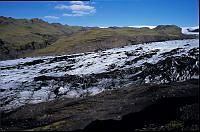Southern Coast Iceland
Field trip M-3
This trip will be led by geologists Oddur Sigurðsson, Icelandic Meteorological Office, and Marion Massé at the University of Nantes, France.
This trip passes into a region of geological activity and flooding resulting from subglacial eruptions. After driving through the plate boundary on the easternmost part of the Reykjanes peninsula, the route passes through the Southern Iceland seismic zone, where four M 6.5 - 6.6 earthquakes occurred in the years 2000 and 2008. The subglacially erupted tuya Ingólfsfjall will be visible from the road between the towns Hveragerði and Selfoss.
Continuing into the lowlands of SW Iceland, the tour leaders will inform about the lavas from the large Þjórsá eruption 8600 years ago, which may be the most voluminous lava flow on Earth during the Holocene (last 11,700 years). Moraines dating from the Younger Dryas cold spell at the end of the ice age (12.9 - 11.7 ka BP) will be visible en route and in good visibility there will be a view towards the volcanoes Hekla and Tindfjallajökull, as well as to the volcanic islands Surtsey and Vestmannaeyjar 10 - 25 km south of the coast.
 The route passes under
Eyjafallajökull, the volcano that shut down air travel within Europe for
a week in 2010. A video on the eruption will be viewed at the farm
Þorvaldseyri. Next stop is the glacier Sólheimajökull, an outlet glacier
from the ice cap Mýrdalsjökull. The tour guides will inform about the
variations of this glacier in historical time, about mass balances and
glacier dynamics, the ages of different moraines and the geomorphology
of the glacier foreland. A walk on the glacier is included in the itinerary.
The route passes under
Eyjafallajökull, the volcano that shut down air travel within Europe for
a week in 2010. A video on the eruption will be viewed at the farm
Þorvaldseyri. Next stop is the glacier Sólheimajökull, an outlet glacier
from the ice cap Mýrdalsjökull. The tour guides will inform about the
variations of this glacier in historical time, about mass balances and
glacier dynamics, the ages of different moraines and the geomorphology
of the glacier foreland. A walk on the glacier is included in the itinerary.
The route continues eastward and participants will walk upon the hill Hjörleifshöfði and have an excellent view over the Mýrdalssandur plains, which have repeatedly been engulfed by catastrophic floods caused by subglacial eruptions in the volcano Katla, within the Mýrdalsjökull ice cap. If time allows, stops will be made at the waterfalls Skógafoss and Seljalandsfoss on the way back to Reykjavík.
Please note that the Sólheimajökull glacier has changed rapidly in recent years, and the glacier can not be accessed from the front anymore. Access at another location has been possible recently. All participants will be required to wear crampons during the glacier walk. The crampons will be provided. It is very important to follow all advice and rules set by the tour leaders. Be careful not to stray away from the group.



